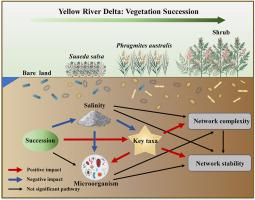Vegetation succession enhances microbial diversity, network complexity, and stability in coastal wetlands, underscoring the pivotal role of soil salinity and key microbial species
IF 8.4
2区 环境科学与生态学
Q1 ENVIRONMENTAL SCIENCES
引用次数: 0
Abstract
In coastal wetlands, vegetation succession is primarily driven by changes in hydrology, sedimentation, and soil salinity. This ecological process is known to significantly influence microbial communities. However, its specific effect on microbial interactions and network dynamics in coastal wetlands remains insufficiently understood. This study adopted a spatial ecological sequence approach instead of a temporal succession method to comprehensively analyze the effects of vegetation succession on microbial communities in the Yellow River Delta. The results demonstrated that soil salinity, rather than nutrient levels, was the primary driver of microbial community shifts during succession. Succession increased the relative abundance of dominant phyla, such as Acidobacteria, Actinobacteria, Chloroflexi, and Planctomycetota, whereas key taxa, including salt-tolerant species, functioned as pivotal nodes regulating community interactions. Co-occurrence network analysis revealed that vegetation succession significantly enhanced the complexity and stability of microbial networks by reducing soil salinity and thereby altering the composition of key microbial taxa. These findings reveal the salinity-mediated mechanisms underlying microbial network assembly during vegetation succession in coastal wetlands and identify environmentally responsive microbial taxa that act as critical connectors within microbial communities, providing a mechanistic basis for the ecological restoration and sustainable management of salinized coastal ecosystems.

植被演替增强了滨海湿地微生物多样性、网络复杂性和稳定性,强调了土壤盐度和关键微生物物种的关键作用
在滨海湿地,植被演替主要由水文、沉积和土壤盐度的变化驱动。这一生态过程对微生物群落有显著影响。然而,其对滨海湿地微生物相互作用和网络动态的具体影响尚不清楚。本文采用空间生态序列方法代替时间演替方法,综合分析了黄河三角洲植被演替对微生物群落的影响。结果表明,土壤盐度,而不是养分水平,是演替过程中微生物群落变化的主要驱动因素。演替增加了优势门的相对丰度,如酸杆菌门、放线菌门、绿菌门和植菌门,而包括耐盐物种在内的关键分类群则是调节群落相互作用的关键节点。共现网络分析表明,植被演替通过降低土壤盐分,从而改变关键微生物类群的组成,显著提高了微生物网络的复杂性和稳定性。这些发现揭示了滨海湿地植被演替过程中微生物网络聚集的盐度介导机制,并确定了在微生物群落中起关键连接作用的环境响应微生物类群,为滨海盐渍化生态系统的生态恢复和可持续管理提供了机制基础。
本文章由计算机程序翻译,如有差异,请以英文原文为准。
求助全文
约1分钟内获得全文
求助全文
来源期刊

Journal of Environmental Management
环境科学-环境科学
CiteScore
13.70
自引率
5.70%
发文量
2477
审稿时长
84 days
期刊介绍:
The Journal of Environmental Management is a journal for the publication of peer reviewed, original research for all aspects of management and the managed use of the environment, both natural and man-made.Critical review articles are also welcome; submission of these is strongly encouraged.
 求助内容:
求助内容: 应助结果提醒方式:
应助结果提醒方式:


